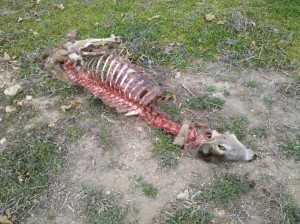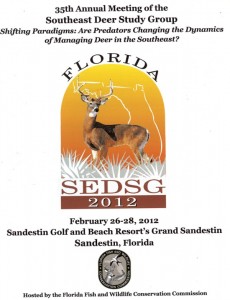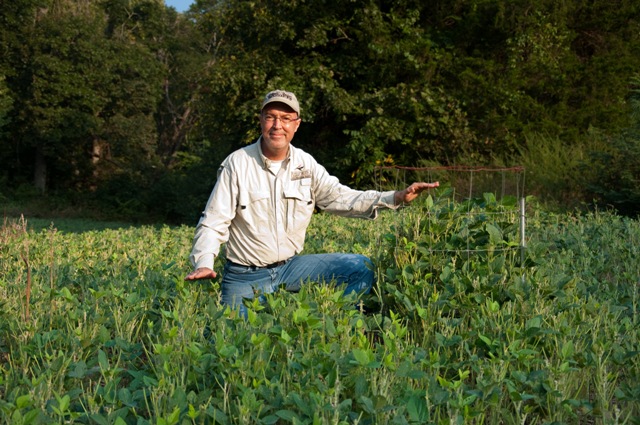Category: Deer Management
Pt. 9: Top 10 Recommendations for Managing Land to Yield Mature, Huntable Deer
Part 9: Predator Induced Stress
Last week I shared with you a summary of Dr. John Kilgo’s long-term research about the amount of fawn mortality primarily caused by coyotes to deer in South Carolina. The results were that 70% of the fawns were killed by predators before the first hunting season after they were born. At that rate of mortality, even without any harvest by hunters, deer populations will decrease. This problem is not everywhere yet. However the number of coyotes, bobcats, black bears, cougars/mountain lions, etc., is increasing rapidly in many areas.
Several of my fellow researchers besides Dr. Kilgo have reported similar findings of predator caused mortality on young deer and even adult deer. Predators are a significant factor on deer populations in many areas!
However, direct mortality is only part of the picture. Even healthy adult deer that are not as susceptible to being killed by predators still can suffer because of high predator populations. Great research on elk in Yellowstone National Park has shown that elk that haven’t been killed by wolves are averaging fewer calves per cow, lower body weights, and the males have smaller antlers on average than before wolves were reintroduced. How can this be? Fewer mouths competing for the same or more food should result in more calves per cow, heavier body weights, and larger antler for each age class.
The answer was found by comparing the levels of specific hormones in elk before they were exposed to wolves and then again five years after wolves had been released into Yellowstone. These hormones are produced and released in critters that are stressed. The levels of these hormones were several times higher in the elk after being exposed to wolves!
This is not surprising. The medical news is full of studies reporting how damaging stress is to human health. Dairy, beef, and even poultry farmers attempt to reduce stress in their stock so they will be more productive. The same is true with game animals. Being chased or even living where they need to be constantly vigilant to avoid predators results in increased stress.
Increases in the number of predator populations (increasing coyote, bobcat, bear, hog, etc.) certainly results in increased stress for several species of game animals.
In addition to reduced health caused by predator induced stress, there is another negative to allowing the predator population to increase significantly.
Deer and turkeys that are constantly vigilant against four-legged predators are also constantly vigilant against two-legged predators. It will likely be more difficult to observe game species on properties that have an abundance of coyotes and other predators. I’ve worked on a few properties that had an abundance of predators. We called and trapped to reduce the number of predators and the observation rate of mature whitetail bucks increased within weeks! These bucks didn’t mature into the population. It is doubtful they moved into the population. They simply became less vigilant.
To have more mature bucks to hunt, there must be more fawns recruited into the population. It’s noticeably easier to have encounters with mature bucks when they are less vigilant. Significantly reducing the number of predators will likely have a positive impact on deer herds. Due to increasing predator populations and decreasing numbers of trappers, predator management is rapidly becoming a significant part of deer and turkey management.
Growing Deer together,
Grant
Pt. 8: Top 10 Recommendations for Managing Land to Yield Mature, Huntable Deer
Part 8: Predators
The past seven entries for this blog have been on the subject of managing for and killing mature bucks. However, in recent years just following the play book for passing bucks and providing quality food, cover, and water may not yield the results you desire. Something has changed across much of the landscape.
It’s the number of predators. When I was a boy (I was born in 1961), coyotes were shot on sight by farmers (almost every farmer I knew always had a rifle in his truck). Raccoon pelts were bringing $50.00 +/- and anyone I knew that was any kind of hunter or outdoorsmen trapped and/or hunted raccoons as a source of additional income. Chicken hawks (any large hawk was called a chicken hawk) were also shot on sight. These actions didn’t cause any of these predators to go extinct.
I went off to college and was taught to feel sorry for predators. I was taught that predators were almost never an issue with game species. That might have been true then (although I had a hard time buying into the theory). I was also taught in college that all natural systems are very dynamic – always changing (I certainly have experienced and agree with that!). Whatever the theories and realities were, the current impact of predators on deer, turkey, quail and other game species are real and measureable!
This last statement is not simply my observations. I had a graduate student five years ago study the impacts of coyote and bobcats on fawn recruitment (fawns surviving until hunting season) on a private property in northern Alabama. Briefly summarized, the results were stunning! He monitored fawn recruitment during year one, then had a trapper remove many coyotes and bobcats from the 2,000 acre property during the following fawning season. During the second fawning season there was a 150+% increase in fawns at the same property as result of removing 20+ coyotes and 10 bobcats! It appeared the turkey and rabbit population also exploded!
When Cory VanGilder (the grad student) presented his resultsat the annual Southeast Deer Study Group Meeting, there wasn’t much excitement among the 100’s of scientists in attendance. Fast forward five years, I just returned from the 35th Southeast Deer Study Group Meeting. Just to give you a hint of the change in attitudes among some of my fellow deer biologists, the theme of the meeting this year was Shifting Paradigms: Are Predators Changing the Dynamics of Managing Deer in the Southeast? Twelve of the 35 presentations were on the subject of coyote predation on deer!
Several of the researchers reported results of fawn mortality documented by the use of vaginal transmitters (VITS). This technology allowed researchers to captures does after they’ve been bred and insert a transmitter in their vagina. The VIT is pushed out of the birth canal when the fawn is born and alerts the researchers by changing the frequency/tone of signal. Researchers can often find the birth site and/or fawn within four hours or less after birth.
Dr. John Kilgo, a talented researcher for the Forest Service, has years of such data. He and his staff have documented that in recent years, 70% of the fawns were killed by predators at their research site (a 300 square mile area in South Carolina) during the first few months after birth! 62% of the total mortality was due to coyotes!! This is not a guess or a theory. At this level of predation, even without any hunting mortality, deer populations will decrease rapidly in number and quality (more on the stress of predation next week).
John and his staff swab the kill site and use advanced techniques with genetic testing to confirm if the killer was a coyote, bobcat, domestic dog, etc. Using this technology, they can tell if it was a male or female predator, and if it was the same predator that killed a fawn ¼ mile or 10 miles way. John’s research is fascinating!
He ended his abstract by saying “I predict that this pressure (coyotes) will require significant changes in how deer populations are managed in the Southeast in the future, because coyotes are here to stay.”
I agree with John, but know from my student’s work and my experience that coyotes can be trapped and their impact on deer populations reduced. Trapping and calling coyotes are fun activities (GDTV 119). However, it requires time and effort. There is no easy method to significantly reduce coyote populations. Some managers will simply let their deer herds be significantly reduced by coyotes. I, and hopefully many others, will not sit by and watch deer populations be reduced significantly by predators. I will actively call and trap coyotes to keep their population in check so deer, turkey, and other game species can maintain a healthy population.
I enjoy hearing a coyote howl. However, I enjoy seeing and interacting with deer and turkeys more. When push comes to shove, I’ll be the deer’s best friend and the coyote’s worst enemy. How about you? Will you sit by and watch America’s favorite game species be reduced to the occasional rare sighting? Or will you join me in protecting the future of hunting?
The damage by coyotes and other predators to deer and other game species is not just direct mortality. Predators also can cause much stress to game species! Next week I’ll share more about this issue.
Growing (and protecting) Deer together,
Grant
Pt. 6: Top 10 Recommendations for Managing Land to Yield Mature, Huntable Deer
Part 6: Flat Ground
I’ve been discussing how to manage land to produce mature and huntable bucks. It’s relatively easy to produce mature bucks. Simply don’t harvest them until they are 4+ years of age. I define mature for whitetail bucks as being four years old or older because by that age most bucks have expressed 90+% of their antler growth potential.
In this blog series I’ve also discussed management strategies which allow bucks to express their antler growth potential. Just because a buck is allowed to live until he is 4+ years of age doesn’t mean he will produce antlers to his full genetic potential. If he hasn’t had access to a quality diet throughout his life and experienced minimal stress, he will not produce antlers as large as his genetic potential.
Now that we discussed several aspects of managing deer so they can express their full genetic potential, I’d like to discuss how to harvest mature bucks. Last week I shared that I’d found several sheds in bottlenecks or pinch points while laying out a habitat management plan on a property in central Missouri.
I really enjoy finding sheds. However, finding where a mature buck has been is not the same as being where a mature buck is – within shooting range! Predicting where a mature buck will be during daylight hours and being there at the same time – especially accomplishing this on a year after year basis – requires a lot of skill and preparation.
Wonder why so many whitetail hunters go to areas that produce commercial row crops year after year? If you look at a map of the whitetail’s range, the portion of the area that produces commercial row crops is a relatively small portion of the whitetails range. Yet, the majority of Boone and Crocket and Pope and Young entries come from the areas where commercial crops are produced.
There are two simple reasons and they both relate to flat ground. Flat ground – especially in the Midwest is almost always better quality soil compared to where the topography is steep and the topsoil has been eroded. However, years and years of producing and harvesting commercial crops have significantly reduced the amount of nutrients and beneficial bacteria in the soil. Without adding fertilizer and beneficial microbes back to the soil, it would not be nearly as productive. These elements are rarely added back to the soil unless it is commercially farmed. Hence they are rarely applied to areas with steep topography.
My property, The Proving Grounds, is a perfect example. It has very steep terrain and was extremely eroded from exceedingly poor timber harvest and agricultural practices decades ago. There literally was no topsoil only rock – literally – only rock. I never disk a plot at my place because it would only shuffle rocks around and cause erosion of the limited amount of organic matter that is present.
However, by adding poultry litter that has been composted with beneficial, soil building bacteria added (Antler Dirt) I’ve significantly improved the quality of crops produced in my food plots. I can now grow quality crops, even on the rocky soil where I never disk! Remember that quality forage and grain crops are only nutrient transfer agents. They serve to transfer nutrients from the soil and air (air is roughly 78% nitrogen – capture that and never pay for nitrogen again!) and transfer those nutrients to deer and other plant consumers.
Some plants are better at capturing nutrients and transferring to consumers (deer, cattle, humans) than others. Those plants typically are the crops grown in commercial ag – to feed humans (and deer). Oak trees transfer nutrients – but the vast majority of the nutrients they transfer are tied up in the wood or the structure of the tree.
Soybeans also transfer nutrients but a much higher percentage of the nutrients they transfer from the soil and air are deposited in the soybean leaves and eventually the soybean pods. Deer readily consume soybean leaves and pods. Deer rarely consume the trunks of oak trees – and never express their full antler growth potential when oak leaves and acorns are most of their diet. This is a primary reason bucks of the same age class living where soybeans are commonly grown will have larger antlers compared to bucks living in areas that are primarily forested.
Some of you are already yelling “acorns.” Acorns are much lower in nutrient content than soybean leaves or pods – there is no comparison between the nutritional quality of acorns and soybeans – or the antlers produced by bucks that primarily consume either crop.
So, if you want to hunt mature deer that have expressed most of their antler growth potential, you need to hunt where the soil has plenty of nutrients and plants that efficiently transfer those nutrients from the soil and air to deer. This can be in regions were commercial crops are grown (flat land), or where quality food plots are maintained.
For example, there isn’t a commercial soybean or corn field for many miles from my property (The Proving Grounds). However, over the years, I’ve converted the few flat spots among the hills where I live to well fertilized food plots and usually plant Eagle Seed forage soybeans. The results have been more than pleasing! My family and I have been blessed to produce and harvest several large, mature bucks.
If your objective is to harvest mature bucks with large antlers, you can go to flat, crop producing ground, or grow the same crops where you hunt. Big antlers start in the dirt – and it usually requires well fertilized flat dirt to grow good nutrient transfer agents (crops like soybeans) to allow bucks to produce their best antlers!
There is another HUGE advantage to managing and hunting deer where the land is flat. I’ll discuss that next week.
Growing Deer together,
Grant
Pt. 5: Top 10 Recommendations for Managing Land to Yield Mature, Huntable Deer
Part 5: Bottlenecks
Yesterday I toured a property in central Missouri with the mission of helping the landowner produce more mature bucks and increase his and his guests’ odds of harvesting them. My comments to the landowner were directly in line with the past four blog entries in this series. We talked about the age structure of the herd on his property, planned several additional feeding and hunting food plots to improve the quantity of quality forage available to the herd, and reviewed the existing cover.
While touring this property four of us found about 20 sheds!
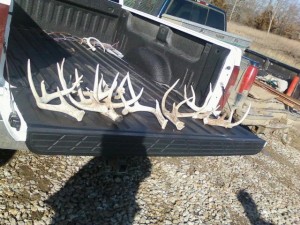
Shed antlers found on the property
Some of these sheds, including the larger ones, were found in bottlenecks.What are bottlenecks? They are physical barriers that limit deer movement to a known and relatively small area. You might call these features pinch points, funnels, etc. Where I was working yesterday, there were several strip pits and dump piles. Strip pits (at least at this property) are about 30’ deep by 150’ wide trenches where coal was mined decades ago. These are now filled with water and are fishing lakes. The dirt from these pits was typically “dumped” close by after the coal was removed.
The dumps are steep, rough, and tough to transverse for man or beast. Deer will certainly go in the dumps and frequently use them as cover, etc., but prefer not to travel through dumps when moving from point A to point B. There were several places where the dumps were within 40-50 yards from the end of a strip pit that was several hundred yards long. The flat ground in between the dumps and the pits created great bottlenecks!
Typically, the longer the barrier (dumps or strip pits on this property) the more utilized the bottleneck. The trails, rubs, etc., we found near the bottlenecks on this property were enough to excite any hunter! I was so excited about the amount of buck sign in these bottlenecks I was ready to begin hanging stands!
My property is just the opposite. It is large patches of hardwoods with a few food plots mixed in. It is very tough to pattern where bucks will travel on my property with any certainty. This is called homogenous habitat. Crop land in the Midwest is full of bottlenecks. Wide open crop fields, especially after the crops have been harvested, tend to funnel buck movement into narrow wood lots, or CRP fields. Where the whitetails move is much more predictable in those areas compared to land that is basically one habitat type (like all woods).
However, bottlenecks can be created! Depending on where I’m working and what’s available, I’ve used discarded round bales of hay, snow fence, etc. Sometimes low value trees can be felled to make bottlenecks. I don’t like this approach as well as others because trees tend to decay rapidly and it’s tough to fell trees in a line with no gaps.
If you are like me and primarily hunt areas where there are very few natural bottlenecks, consider using a readily available resource and creating some. Consider how to approach the stand, wind direction, etc. It’s often easier to grow mature bucks than it is to harvest mature bucks. Creating a bottleneck is an outstanding tool to reap the benefits of your deer management efforts.
Growing (and killing) Deer together,
Grant
Pt. 4: Top 10 Recommendations for Managing Land to Yield Mature, Huntable Deer
Part 4: Adult Sex Ratio
In this blog I’ve been addressing a question posted on my Facebook page. The question was “What are your top 10 recommendations for managing land to yield mature, huntable deer?” During recent blogs, I’ve described the importance of age, nutrition, and cover in managing land to yield mature, huntable bucks.
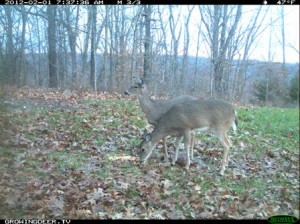
Two does
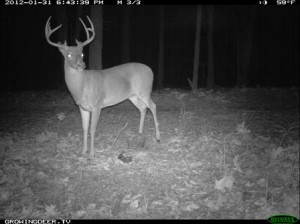
Buck near a Trophy Rock
If you’ve read those blog entries, it is obvious that reducing stress is a common theme to achieve the goal of managing for mature, huntable bucks. An equally important herd characteristic that should be managed is the adult sex ratio. The adult sex ratio is simply the number of bucks to does that are at least 1.5 years old. If a herd was composed of five bucks and ten does that were 1.5 years old or older, that herd’s adult sex ratio would be 1:2.
The adult sex ratio has several implications on the herd’s health and huntability, especially for mature bucks. It is common for a buck to attempt to tend a doe before she is receptive and remain near her for 24-48 hours. While he is “tending” that doe, other does may also be receptive. In fact, if the herd’s adult sex ratio is skewed heavily toward does, some does may cycle through their receptive period without being bred.
This results in them becoming receptive again about a month later. When this occurs, it means she will produce fawns a month later (or more if she cycles multiple times). This results in fawns being born later when conditions for fawning are probably not as favorable. As the summer progresses forage quality tends to decrease, insect loads become higher, the temperatures become higher, etc. Simply stated the conditions for prospering as a fawn tend to decline as the summer progresses.
Deer probably won’t express their full potential as an adult if they didn’t have all the required resources as a fawn. In addition to providing good quality forage (nutrition) and cover, it is just as important to ensure the adult sex ratio is balanced so the majority of fawns will be born during the optimal time for growth and reduced stress.
The older age classes also benefit from being part of a herd with a balanced adult sex ratio. It is very stressful for mature bucks to participate in the rut. Captive bucks in relatively small enclosures (less than five acres) and that have access to all the supplemental feeds they can consume have been reported to lose +/- 30% of their body weight during the rut. Given this, imagine the cost of participating in the rut for free-ranging wild bucks that must search for quality food, be constantly alert for two and four legged predators, and face all the daily challenges that captive deer avoid. In addition to the challenges of surviving, if a buck is part of herd where the adult sex ratio strongly favors does, the duration that he will seek, chase, and tend does is greatly extended simply because some does will not be bred during their first receptive cycle.
Likewise yearling bucks that are not fully mature will seek, chase, and tend receptive does as mature bucks are occupied with other receptive does. Yearling bucks would most likely develop better if they were dissuaded from chasing does by the presence of mature bucks (and their pheromones). Immature bucks need a huge amount of resources simply to maintain skeletal and body growth. The resources expended by participating in the rut may well limit the resources available for skeletal and body growth.
Likewise, it takes resources for does to cycle through her receptive period multiple times and nurture a fawn or fawns past the prime fawn rearing season.
Bucks, does, and fawns simply do best when they are born and rut during a natural timeframe and cycle. The best tool to ensure your herd is breeding and fawning at the optimal times is to manage the herd for a balanced adult sex ratio and ensure the population doesn’t exceed the habitat’s ability to supply quality forage.
In addition to a healthier herd, another huge benefit to managing for a balanced adult sex ratio is that that competition for breeding will likely be more intense and therefore bucks may be more active and most likely hunting strategies such as calling, rattling, using decoys, etc. may be more effective than in herds where there is not as much competition during the rut.
A great tool to manage your land to yield mature, huntable bucks is to establish and maintain a herd with a balanced adult sex ratio.
Growing Deer together,
Grant
Pt. 3: Top 10 Recommendations for Managing Land to Yield Mature, Huntable Deer
Part 3: Cover
During the past two weeks I’ve been addressing a question posted on my Facebook page. In those blogs, I discussed the importance of age and nutrition in managing land to yield mature, huntable bucks.
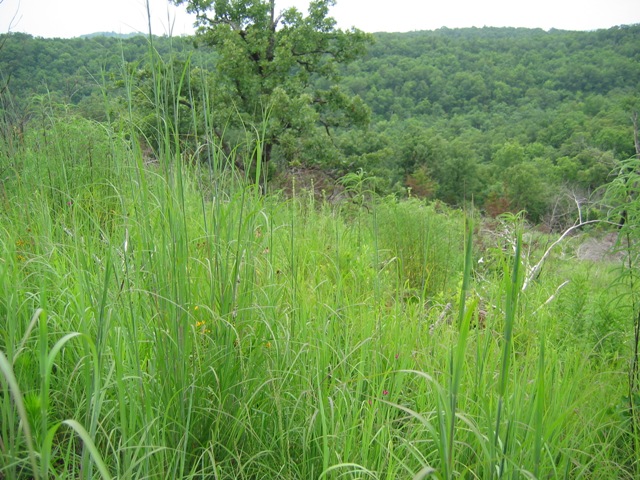
Area of cover for white tail deer
Next on my list of top 10 recommendations for managing land to yield mature, huntable whitetails is the need for cover. I define cover as areas where deer are likely to feel more secure compared to surrounding areas. In the Deep South cover may be shade, or in a colder climate native grass that serves to block the wind but allow the sun’s radiant energy to reach the deer. Cover may be areas where predator populations such as coyotes are reduced to be in balance with prey species.
Quality cover serves to reduce stress levels of deer and therefore allows them to express more of their antler growth and fawn producing potential. Cover can be just as beneficial to a deer herd as quality nutrition, depending on the sources of stress. However, one without the other means the deer herd likely won’t express its potential.
The best cover is not only a particular type of structure (shade, native grass, etc.), but also an area of reduced predation. Hunters are predators. To maximize the reduction of the level of stress it is best to combine the structure of cover while also making it a sanctuary (prohibit entry by humans during most of the year).
Sanctuaries are the least expensive form of cover to create. It simply means not entering an area. Sanctuaries with desirable cover are very beneficial to deer. To benefit the deer herd where you hunt, don’t just think about ways to attract them and make the deer easier to see, but think about managing enough of the habitat to insure each deer has a place where they believe they won’t be seen. This is not a totally unselfish act by hunters. Sanctuaries should result in a healthier herd, and one that is easier to hunt as deer that feel secure are not as alert.
My third recommendation for managing land to yield mature, huntable bucks is to create areas where they are “un-huntable” – create some sanctuaries!
Growing Deer together!
Grant
Pt. 2: Top 10 Recommendations for Managing Land to Yield Mature, Huntable Deer
Part 2: Nutrition
Last week I started addressing a question posted on my Facebook page about how to manage land to yield mature, huntable deer. The subject of that blog was how important age is to allowing bucks to express their antler growth potential. In addition, by allowing more bucks to mature, there will be more bucks to harvest – more bucks usually equates to better hunting.
However, there are lots of areas with a relatively high density of mature bucks, but very few bucks with good antler development. This often occurs in areas where hunting is not allowed and no habitat management activities occur. These areas include preserves, parks, etc. For bucks to express their genetic antler development potential, they must be allowed to 1) mature, 2) and have access to quality forage.
I remember visiting years ago with a wise gentleman when another person entered the conversation and shared an image of a very large buck recently harvested for that area. My friend instantly said “I bet that buck was harvested within a mile of one of the few soybean fields.” The gent with the image said “how’d you know?” My friend simply said, “All the big deer killed in this county are harvested by the soybean fields.”
My friend knew that big bucks are usually seen where the combines roam. His statement was not only correct for that county, but throughout the whitetails’ range. Compare the following maps. The first shows the distribution of soybeans grown throughout the continental states and the second shows the distribution of B&C and P&Y bucks harvested up to 2005. The correlation is not perfect, but it’s close enough to make the point.
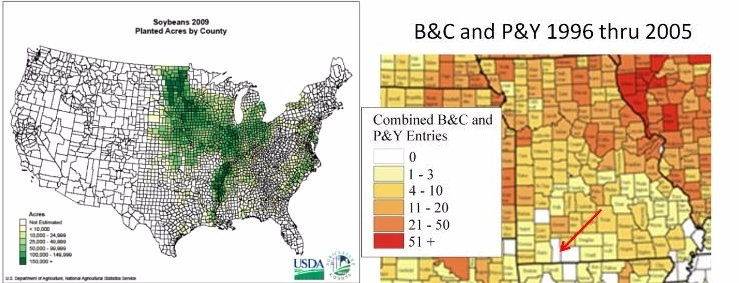
Planted soybean acres by county compared to big bucks by county.
The good news is that soil can be improved anywhere – even if the land you hunt is not shaded green on the soybean map. Notice that it’s a long way to any green on the map from where I live (Stone and Taney counties, MO). Even so, I grow great soybeans (and deer) using the combination of Eagle Seed beans, Antler Dirt fertilizer, and no-till drill techniques.
To have huntable mature bucks requires allowing bucks to mature and have access to good forage so they can express their antler growth potential. Good forage serves two purposes of allowing deer to express their potential and serving as an attractant so mature bucks can be patterned.
Insuring quality forage is available year round is #2 on my top 10 list of managing land to yield mature, huntable bucks.
Growing Deer together,
Grant
Pt. 1: Top 10 Recommendations for Managing Land to Yield Mature, Huntable Deer
Part 1: Age
Earlier this week I received a very good question on my Facebook page. Dan Dealy asked “Dr. Woods, what are your TOP TEN recommendations for managing land (and wildlife) to yield mature, huntable deer?”
One of the keys to Dan’s question was the second to last word –“huntable.” Most managers and hunters consider food, cover, and water, but they don’t consider how to make a property “huntable” or hunter friendly for mature bucks.
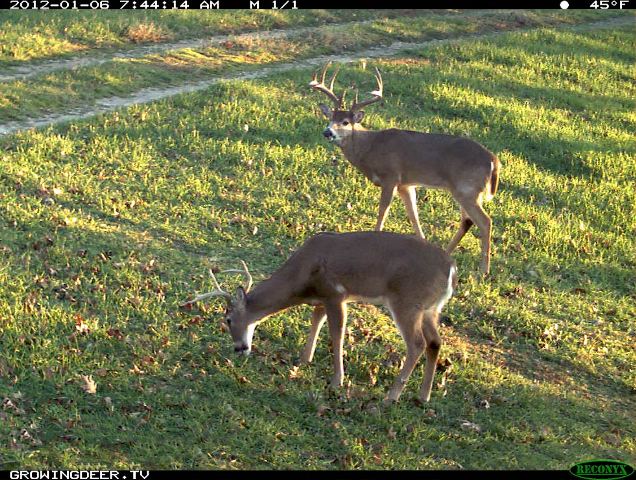
Last Lick Big 10 and Pumpkin Face
For a property to be huntable for mature bucks – for a hunter to have better than average odds of harvesting a mature buck – there are several factors that must be considered. To discuss all of these in detail would require a book (like Deer Management 101). In my next few blog posts, I will share some thoughts about my top ten recommendations to produce a huntable population of mature bucks. I apply these strategies and techniques to my property and have applied them to those of my clients for 20+ years. They are not deep secrets or magic recipes. They are proven and practical.
Having realistic expectations is the first step to satisfaction. It is important to understand that having huntable mature bucks doesn’t mean there will be Boone and Crocket class bucks behind every tree. A buck is mature to me when they are 4 years old or older. This is when bucks grow the largest antlers because most of their skeletal development is complete and they can use most of their excess resources to produce the biggest antlers of their genetic potential. Few free-ranging bucks express their genetic potential. In my opinion, many hunters, writers, etc., waste way too much time talking about whitetail genetics.
First, it’s very difficult to alter the gene pool of a free-ranging herd of whitetails. Second, there is probably nothing wrong with the genetics, but ample room for improvement of the habitat and herd structure.
With that said, my number one factor to improve the yield of huntable mature bucks is to have more mature bucks. To get more mature bucks, immature bucks must be passed and allowed to grow. Rule #1 the in Woods’ Book of Deer Management is that “Dead Deer Don’t Grow.” It sounds simple, but some hunters still don’t understand. They harvest a good looking two year old buck and then complain that they never harvest a “monster buck.” They’ve probably harvested several monster bucks – they just shot them before they matured and were allowed to express their genetic potential to produce large antlers! Bucks typically produce larger antlers as they age. University research shows that two and three year old bucks produce on average about 50 and 75% of their antler growth potential. It’s not until bucks mature to four years old that they express, on average, about 94% of their antler growth potential. To have an opportunity to harvest mature bucks, you must hunt where bucks are allowed to mature. That’s #1 in my top 10 recommendations for managing land to produce huntable mature bucks. The more bucks that are allowed to live to 4+ years of age, the easier it will be to harvest a mature buck. I’d much rather hunt a property that has three mature bucks per square mile than one or no mature bucks per square mile.
The least expensive form of deer management is trigger finger management. It simply costs less to pass immature bucks than any other form of management for establishing a hunter friendly population of mature bucks.
During 2012 – if you want to tag a mature buck, be prepared to pass immature bucks. Yes, others in your area may kill immature bucks. However, the trend must start somewhere and it is most likely to start with you. Share the education with other hunters in your area. You don’t have to convince all of them, but you won’t convince any of them when gathered around an immature buck you just harvested.
Remember, the first rule of deer management – “Dead Deer Don’t Grow.”
Growing (huntable mature bucks) Deer together,
Grant
When Bucks Grow the Largest Antlers
Ben Hampton, Prostaff on Midwest Whitetail, recently shared the pictures of this super buck with me. He found the buck’s sheds last year and they grossed 154 4/8 (172 4/8 with an 18′ spread) as a typical 6×6 and this year he grossed 174 3/8 as a 6×5, with an additional 10 non-typical points he didn’t have last year, for a total gross non-typical score of 191 6/8. Ben asked me if it was typical for a deer to make this big of jump between 5 and 6 and if the bad drought they experienced in the summer of 2010 could have suppressed last year’s rack.
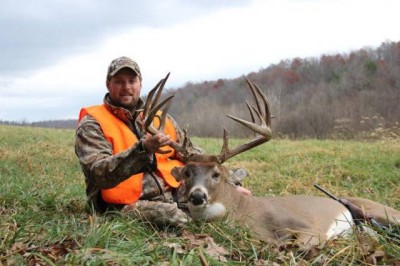
21 point buck harvested by Ben Hampton
Bucks, just like humans, are individuals. Some bucks produce larger antlers earlier than others. I was the tallest kid in 1st grade. Folks wanted me on their basketball team. By the time I was in high school, I didn’t make the team. Some bucks grow early, some mature late.
On average (averages represent populations – but almost never an individual) bucks express 94% of their antler growth potential by age 4.5. However, most wild deer don’t have access to quality forage year round. There have been bucks in research locations that barely scored 120 and then blew up to 200+ once given a better diet.
By being allowed to mature and having access to better forage created a perfect scenario for the buck Ben harvested to express his full antler potential. His timing was perfect.
So – in general, the better the year round forage, the later in life bucks will express their full antler growth potential.
Congratulations Ben, that’s a fabulous buck!
Growing Deer together,
Grant
Bucks Shedding Antlers Early
Adam called me two days ago with a bitter sweet message. He had found a shed from Giant 8. It was bitter because I had used some Reconyx cameras to understand Giant 8’s post late season feeding pattern. I had a Muddy hung, and felt I could tag him when the temperatures dropped and he needed to feed more during the daylight to gain calories to maintain his body weight. That plan is now canceled.
The sweet part is that his shed was found in one of two food plots that I had determined where Giant 8 was feeding. My scouting was spot-on! In addition, I’d rather the shed be found and confirmed it was a clean shed (no sign of injury, brain abscess, etc.) than he simply disappear.
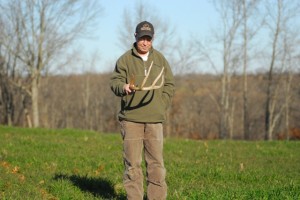
- Grant holding shed from Giant 8
I host an annual shed hunt during March. Even though March is relatively late for many shed hunters, we always jump a buck or two that still has antlers. However, I have multiple images of bucks that have shed early this year. In addition, folks from throughout the whitetail’s range have commented on my Facebook page about bucks shedding early in their neighborhood.
I expected bucks to shed earlier than normal this year – but not this early. Bucks will shed early when they are stressed. It was the fourth driest summer on record where I live. In addition to the lack of moisture, several months were recorded as the hottest or some of the hottest on record. Those hot and dry conditions caused a huge amount of stress to Eagle Seed beans planted in my plots. I was shocked they grew as well as they did – my other crops perished.
To a deer manager, forage plants are simply nutrient transfer agents. They simply transfer nutrients from the soil and air to the consumer (deer). No matter how many nutrients are available, plants can’t transfer nutrients without water. Soil moisture was so limited this year that the plants simply couldn’t transfer many nutrients. The heat directly and indirectly caused a huge amount of stress to bucks in my area this year.
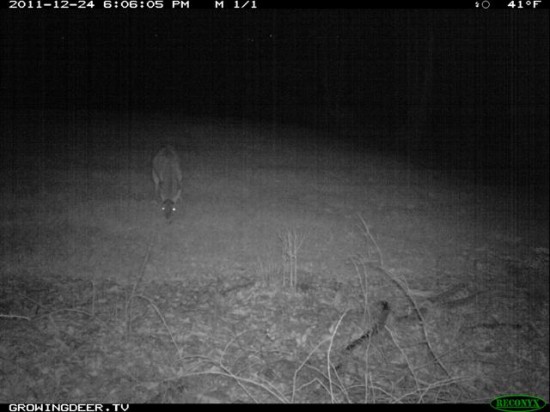
Giant 8 after he shed his antlers
I was shocked that the antler production was as good as it was during 2011. This was confirmed by comparing some sheds we found last year to some mature bucks that were harvested here this year (most notably Giant 10). I was pleasantly surprised that they actually produced larger antlers than during the previous year when the growing conditions were much better! This is a great testimony of the relationship between age and antler development. If you wish to harvest bucks with larger antlers, allow the bucks where you hunt to mature and provide the best nutrition you can afford. Food plots are relatively easy to produce and can definitely yield great results in allowing bucks to be healthier (larger antlers) and easier to hunt.
However, a buck’s antler growth potential (genetic potential) can only be expressed if the buck is allowed to live until it reaches older age classes AND has access to quality nutrition year round. It seems my buck hunting may be over soon even though the legal season where I live extends to January 15th. I learned some very valuable lessons about managing for and hunting mature bucks during the drought of 2011. I’ll be a better manager during 2012. I will continue sharing what I learned in this blog and each week in the video episodes of http://www.GrowingDeer.tv. Thank you for being part of the http://www.GrowingDeer.tv team and for sharing what you’ve learned and observed with us. May you be blessed with a great 2012.
Growing Deer together,
Grant



